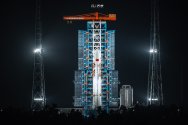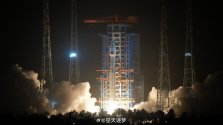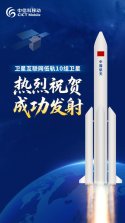You are using an out of date browser. It may not display this or other websites correctly.
You should upgrade or use an alternative browser.
You should upgrade or use an alternative browser.
China's Space Program Thread II
- Thread starter Blitzo
- Start date
10th batch of Guowang Constellation has launched.9th batch of Guowang Constellation has launched.
this is the 5th batch of satellites being launched in 21 days..
A Long March 6A lifted off from Taiyuan, sending the 9th group of Guowang broadband satellites into orbit.
this is the 6th batch of satellites being launched in 30 days.
by78
General
The first image shows Zhongke's launch complex at Jiuquan. The launchpad for Lijian-1 is on the right, and the Lijian-2 launchpad is on the left. The last three images show the full scale model of Lijian-2 being used to practice launch procedures.

Zhongke/CAS Space has successfully completed commissioning trials of the launch equipment for its Lijian-2 rocket.





I thought LM [long mrach] had been replaced by putonghua ChangZingEnd 2025 – Seven Longyun engines will power the first stage of the reusable LM-12A marking the first time a Chinese commercial engine has been selected for a national-team launch vehicle:
View attachment 159287
Pretty self-explanatory, although I will give a little refresher on what the Nuwa Constellation is, briefly. It is China's largest commercial radar remote-sensing constellation at the moment, it combines X-band SAR, plans for C-band SAR, and optical satellites to deliver all-weather, day-night Earth observation and InSAR deformation monitoring. They are planning Phase 1 for 54 satellites, potential to expand to 114 over time. These satellites are crucial for disaster response and agriculture, along with a host of other uses.
I'll put some of the relevant quotes below, translated of course.
While one rocket is undergoing tests, the team is simultaneously carrying out final assembly on the next vehicle and building a new vertical test/checkout platform, advancing on three fronts in parallel. Taking advantage of gaps during testing of the Yao-2 Long March-8A, the assembly team has been strapping the boosters to the core first stage of the Yao-4 vehicle in parallel—hooking slings, erecting, moving, and mating—each step proceeding in an orderly, seamless flow. On the day after the Yao-2 was hoisted onto the launch tower at the pad, Yao-4 rolled in without a gap and stood up on the vertical checkout platform. Compared with the traditional test-and-launch flow, this parallel mode can shave about one week off the on-site campaign, improving responsiveness for high-frequency launches.
Meanwhile, construction of a second vertical checkout platform is proceeding at full speed. Once completed, the program team will be able to test two rockets in parallel, doubling its integration and test capacity. “That means the annual launch count for Long March-8A can increase from around 10 to around 20, better meeting the demands of high-cadence missions,” explained Liu Congcong of CALT. The new vertical platform is expected to complete installation and commissioning in October.
Article goes over a lot of their finances and status, they are simply reapplying to the Hong Kong Stock Exchange once again for an IPO.
And finally, although perhaps smaller,
To keep it simple once again, this center will focus on "promoting the landing of high-level technological achievements in commercial aerospace and the low-altitude economy."
17 initial measurements were done, and 38 distance measurements followed. China is just the fourth nation to achieve this feat after France, Germany, and the United States. The reflector presented challenges as well, as given by Han Xida, one of the engineers, in this quote (borrowing a translation since I have one):
“Unlike previous-generation corner reflectors, NGLR-1 is a single, solid object with a 10-centimeter aperture, rather than a spliced assembly. In essence, we must detect this 10-centimeter object amidst the vast lunar landscape. Its smaller target presents greater observational challenges, yet delivers higher precision. It eliminates distance expansion caused by lunar libration effects in previous laser reflectors, providing enhanced ranging accuracy to support long-term research in lunar physics, astrophysics, and cosmology.”
The article itself is about a bunch of other movies, so here is the relevant part:
China’s first 8K film shot in space, 'Blue Planet Outside the Window', will be released on September 5, with presales opening today. It is the first movie to carry China Media Group’s Film Channel logo and open in theaters nationwide. For the first time, the film reveals the 183-day epic journey of Shenzhou-13 and the China Space Station, giving audiences a unique perspective on the wonders of the cosmos.
Several good points in the article, mostly discussing the development of the satellite communications industry, in which they estimate it will have 10 million users by 2030. This seems more like a guiding document as the title says, rather than something more concrete, in my opinion. Here is the article, I have translated it:
According to CCTV News, the Ministry of Industry and Information Technology (MIIT) today (August 27) released the Guiding Opinions on Optimizing Business Admission to Promote the Development of the Satellite Communications Industry. The document sets out that by 2030, the regulatory system and policies for satellite communications will be further improved; new models and business forms—such as mobile phones directly connecting to satellites—will see large-scale application; and the number of satellite-communications users will exceed 10 million. It calls for accelerating the development of low-Earth-orbit (LEO) satellite internet to realize global broadband coverage; supporting direct-to-satellite services for mobile phones and other terminals to foster economies of scale; organizing commercial trials of satellite IoT; studying the establishment of new types of satellite-communications services; and further opening the sector to private enterprises.
MIIT stated it will support state-owned satellite-communications enterprises in speeding up LEO satellite-internet deployment; support telecom operators in offering direct-to-satellite connections for phones and other terminals; and support private companies in exploring satellite IoT and other emerging services. The opening of satellite-communications services will be advanced in an orderly manner, differentiated by service category, by phase, and by steps. The ministry will fully leverage satellite-communications advantages, supporting applications in emergency communications, digital public-benefit services, and other traditional fields. It will strengthen the integration of satellite communications with next-generation information infrastructure, promoting direct satellite connectivity for phones, automobiles, aircraft, and more.
At present, satellite internet is developing rapidly, and space–ground integration has become an important trend and characteristic of the ICT industry. Satellite communications are quickly expanding from specialized domains to the mass market and are expected to form a new engine of economic growth. Promoting the integrated development of satellite and terrestrial mobile communications will facilitate convergence with 5G/6G, artificial intelligence, and other next-generation information technologies, providing ubiquitous coverage and stable, reliable communications assurance.
The meeting was co-chaired by both Bian Zhigang, the Deputy Administrator of the CNSA, and Supachai Pathumnakul, the Permanent Secretary of the Ministry of Higher Education, Science, Research and Innovation, for Thailand. The Second China–Thailand Space Science & Technology Workshop also took place. It was largely a review of progress, as far as we know currently, but further developments may come of the meeting. Thailand is a part of the ILRS and is looking to further partner with China, they have signed multiple MoUs, and Thailand will also participate in the Chang'e 7 mission with a payload. There is much more to be said about their cooperation, hopefully this yields more.
They used a combination of BeiDou, UAVs, and other aspects to measure these. I included this because I think it highlights the more niche and unexpected contributions that BeiDou can provide to the government and the people.
Article:
Where is Jiangsu’s highest mountain—and how high is it?
At the Jiangsu provincial main event for 2025 Surveying and Mapping Law Publicity Day & National Map Awareness Week on August 27, the Jiangsu Provincial Department of Natural Resources and the Jiangsu Provincial Department of Civil Affairs jointly released elevation data for the province’s top ten peaks by altitude. The data have been approved by the People’s Government of Jiangsu Province. Among them, the elevations for Yunü Peak in Lianyungang’s Lianyun District and Beigaofeng in Nanjing were drawn from figures previously published at the national level; the remaining eight peaks’ elevations are the latest measurements from 2025.
This marks the first time Jiangsu has organized a systematic, high-precision elevation survey of the province’s major peaks. The Jiangsu Institute of Surveying and Mapping Engineering, which carried out the work, innovatively adopted a “BeiDou + leveling + 3D” approach, using domestically developed, high-end surveying hardware and software. Leveraging technologies such as BeiDou satellite navigation, UAV remote sensing, and digital twins, the team achieved a shift from “2D labels” to “3D presentation” of mountain features—showcasing the technological strength and equipment confidence of “Made in China.”
Survey crews trekked through forests, climbed steep slopes, and braved wind and rain. In just one month, they efficiently completed field data collection and indoor processing and computation.
The campaign obtained high-accuracy horizontal positions and precise elevations for the peaks and built true-to-life 3D models. These rich outputs not only resolve the historical headache of “the same mountain with different heights,” but can also be widely applied to administration, news reporting, and teaching and research across the province. The public can even “tour the mountains in the cloud”—walking virtual trails and taking in natural scenery from above—for a perceptible, interactive experience.
At the same time, the accurate data provide a scientific, unified, and authoritative spatio-temporal information foundation for territorial spatial planning, arable land protection and utilization, geological surveys, ecological restoration, disaster prevention and mitigation, and cultural tourism—offering important support for smart government and the digital economy.
Again, another use of BeiDou here. I will just include the relevant paragraph/sentence.
In the primary sector, the focus is on raising the digital and intelligent levels of agricultural machinery and farming facilities. Across the province, two BeiDou-based, comprehensively integrated smart farms and eighteen BeiDou-based intelligent-agriculture demonstration bases are being built, creating fully digital, unmanned farms with integrated ‘sky–space–ground’ operations. The scale of these applications ranks first in Central China and among the leading in the country, with data-intelligence technologies deeply integrated into modern agriculture to build the ‘Jianghan Granary.’
Investment funds for the Yangtze River digital industry, the BeiDou industry, and the artificial-intelligence industry have each reached the 10-billion-yuan level.
Also I would like to ask, would anyone like to see more Chinese space research papers (like astrophysics or astronomy, related fields) and would anyone like to see more Chinese space finance-related news?
Absolutely! Yes - on all these points.
17 initial measurements were done, and 38 distance measurements followed. China is just the fourth nation to achieve this feat after France, Germany, and the United States. The reflector presented challenges as well, as given by Han Xida, one of the engineers, in this quote (borrowing a translation since I have one):
The article itself is about a bunch of other movies, so here is the relevant part:
Several good points in the article, mostly discussing the development of the satellite communications industry, in which they estimate it will have 10 million users by 2030. This seems more like a guiding document as the title says, rather than something more concrete, in my opinion. Here is the article, I have translated it:
The meeting was co-chaired by both Bian Zhigang, the Deputy Administrator of the CNSA, and Supachai Pathumnakul, the Permanent Secretary of the Ministry of Higher Education, Science, Research and Innovation, for Thailand. The Second China–Thailand Space Science & Technology Workshop also took place. It was largely a review of progress, as far as we know currently, but further developments may come of the meeting. Thailand is a part of the ILRS and is looking to further partner with China, they have signed multiple MoUs, and Thailand will also participate in the Chang'e 7 mission with a payload. There is much more to be said about their cooperation, hopefully this yields more.
They used a combination of BeiDou, UAVs, and other aspects to measure these. I included this because I think it highlights the more niche and unexpected contributions that BeiDou can provide to the government and the people.
Article:
Again, another use of BeiDou here. I will just include the relevant paragraph/sentence.
Also I would like to ask, would anyone like to see more Chinese space research papers (like astrophysics or astronomy, related fields) and would anyone like to see more Chinese space finance-related news?











